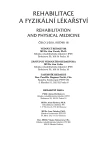Chest Expansion, Ventilatory Parameters and Selected Kinesiologic Indices in Patients with Bronchial Asthma and Chronic Obstructive Disease
Authors:
K. Neumannová
Authors‘ workplace:
Katedra fyzioterapie, Fakulta tělesné kultury UP, Olomouc, vedoucí katedry prof. MUDr. J. Opavský, CSc.
Published in:
Rehabil. fyz. Lék., 18, 2011, No. 3, pp. 132-137.
Category:
Original Papers
Overview
Bronchial asthma (AB) and chronic obstructive pulmonary disease (COPD) are chronic pulmonary diseases which can lead to health problems and complication. The aim of this study was to assess the effect of pulmonary rehabilitation treatment on chest expansion, ventilatory function, kinesiologic findings and symptoms of these diseases. The examined group consisted of 92 patients. Chest expansion, pulmonary function tests (spirometry), kinesiologic examination and baseline interview were examined and assessed at the beginning and at the end of pulmonary rehabilitation treatment. The initial and final results were statistically compared. The results were also compared with results of a control group (consisting of 106 healthy people). The results of this study show that AB and COPD patients had lower chest expansion, higher number of shortened and weak muscles. I noticed decreased values of vital capacity, forced expiratory volume in one second, peak expiratory flow and maximal expiratory flow in patients with COPD. There were significant improvements of chest expansion and ventilation function at the end of pulmonary rehabilitation treatment. The presence of disease symptoms was also lower in AB and COPD patients at the end of pulmonary rehabilitation treatment. From given results it can be concluded that pulmonary rehabilitation treatment is an important part of comprehensive treatment in AB and COPD patients.
Key words:
bronchial asthma, pulmonary rehabilitation, ventilatory function, muscle imbalances, symptoms of disease
Sources
LITERATURA
1. GINA (2009). Global Strategy for Asthma Management and Prevention [online]. Retrieved 2. 10. 2010 on the World Wide Web:
2. GOLD (2009). Global Strategy for Diagnosis, Management, and Prevention of COPD [online]. Retrieved 2. 10. 2010 on the World Wide Web:
3. GREEN, R. H., SINGH, S. J., WILLIAMS, J., MORGAN, M. D. L.: A randomised controlled trial of four weeks versus seven weeks of pulmonary rehabilitation in chronic obstructive pulmonary disease. Thorax, 56, 2001, s. 143-145.
4. HALADOVÁ, E., NECHVÁTALOVÁ, L.: Vyšetřovací metody hybného systému. Brno, Národní centrum ošetřovatelství a nelékařských zdravotnických oborů, 2003.
5. CHAITOW, L.: Biomechanical influences on breathing. In L. Chaitow, D. Bradley, & Ch. Gilbert (eds.): Multidisciplinary approaches to breathing pattern disorders. Edinburgh, Churchill Livingstone, 2002, s. 83-109.
6. JANDA, V., HERBENOVÁ, A., JANDOVÁ, J., PAVLŮ, D.: Svalové funkční testy. Praha, Grada Publishing, 2004.
7. KOLÁŘ, P., LEWIT, K.: Význam hlubokého stabilizačního systému v rámci vertebrogenních obtíží. Neurol. pro praxi, 5, 2005, s. 270-275.
8. LAGHI, F., TOBIN, M. J.: Disoders of the respiratory muscles. Am. J. of Respir. Crit. Care Med., 168, 2003, s. 10-48.
9. LAPIER, T. K., COOK, A., DROEGE, K., OLIVERSON, R., RULON, R., STUHR, E., YATES, D., DEVINE, N.: Intertester and intratester reliability of chest excursion measurements in subjects without impairment. Cardiopul. Phys. Ther. J., 11, 2000, s. 94-98.
10. LEWIT, K.: Manipulační léčba v myoskeletální medicíně (5th ed.). Praha, Sdělovací technika, 2003.
11. LIEBENSON, C.: Re-education of faulty respiration. J. Bodywork Mov. Ther., 3, 1999, s. 225-228.
12. LOPES, E. A., FANELLI-GALVANI, A., PRISCO, C. C. V., GONCALVES, R. C., JAKOB, C. M. A., CABRAL, A. L. B., MARTINS, M. A., CARVALHO, C. R. F.: Assessment of muscle shortening and static posture in children with persistent asthma. Eur. J. Pediatr., 166, 2007, s. 715-721.
13. RIES, A. L., KAPLAN, R. M., LIMBERG, T. M., PREWITT, L. M.: Effects of pulmonary rehabilitation on physiologic and psychosocial outcomes in patients with chronic obstructive pulmonary disease. Ann. Inter. Med., 122, 1995, s. 823-832.
14. RYCHLÍKOVÁ, E.: Manuální medicína (2nd ed.). Praha, Maxdorf, 1997.
15. SMOLÍKOVÁ, L., MÁČEK, M.: Respirační fyzioterapie a plicní rehabilitace. Brno, Národní centrum ošetřovatelství a nelékařských zdravotnických oborů, 2010.
16. VAŘEKOVÁ, R., VAŘEKA, I., BURIANOVÁ, K., ZDAŘILOVÁ, E., RIEGROVÁ, J., HAK, J:. Srovnání výskytu svalových dysbalancí a držení těla mezi dětmi s asthma bronchiale a běžnou populací. Česká antropologie, 55, 2005, s. 126–128.
17. VERRILL, D., BARTON, C., BEASLEY, W., LIPPARD, W. M.: The effects of short-term and long-term pulmonary rehabilitation on functional capacity, perceived dyspnea, and quality of life. Chest, 128, 2005, s. 673-683.
18. WHO (2008a). Bronchial asthma [online]. Retrieved 25. 10. 2008 on the World Wide Web:
19. WHO (2008b). Chronic obstructive pulmonary disease [online]. Retrieved 25. 10. 2008 on the World Wide Web:
Labels
Physiotherapist, university degree Rehabilitation Sports medicineArticle was published in
Rehabilitation & Physical Medicine

2011 Issue 3
- Hope Awakens with Early Diagnosis of Parkinson's Disease Based on Skin Odor
- Deep stimulation of the globus pallidus improved clinical symptoms in a patient with refractory parkinsonism and genetic mutation
Most read in this issue
- Chest Expansion, Ventilatory Parameters and Selected Kinesiologic Indices in Patients with Bronchial Asthma and Chronic Obstructive Disease
- Therapy and Training with Vibrations: Acctual Trend or Effectives Procedures?
- Results of the Investigation Among Participants of the Course in „Diagnostics and Pain Management in Rehabilitation”
- Statistical Evaluation of Treatment Efficiency in Pain Conditions of Lumbosacral Region
